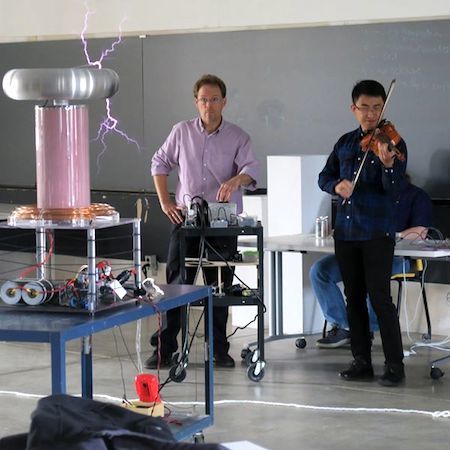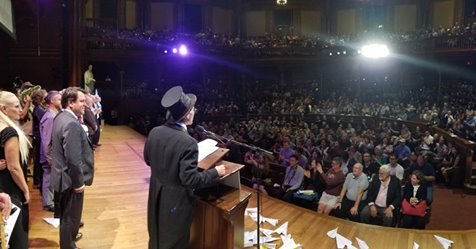Marc Abrahams's Blog, page 172
September 14, 2018
A whinny, pooh-poohing the Ig Nobel Prizes
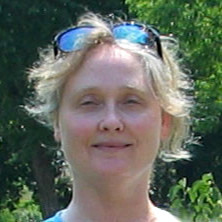 Annmarie Throckmorton sent us this note today, expressing her level of delight at the Ig Nobel Prizes:
Annmarie Throckmorton sent us this note today, expressing her level of delight at the Ig Nobel Prizes:
And Science wonders why more little girls don’t go into STEM education. The answer for Improbable is that no one wants to be publicly called “poo” which is a synonym for SHIT. How mean and stupid are you? There is a lot of sneaky passive-aggressiveness, and toward a child no less, in what the Ig Nobels do each year.
“Established in 1991, the Ig Nobels are a good-natured parody of the Nobel Prizes…Acceptance speeches are limited to 60 seconds, strictly enforced by an eight-year-old girl nicknamed “Miss Sweetie-Poo,”*
Source: https://arstechnica.com/science/2018/09/the-serious-science-of-the-ig-nobel-prizes-will-make-you-laugh-then-think/
Again, there is nothing “good natured” about publicly addressing an eight-year old girl as “Miss Sweetie-Poo.” The fact that the Ig Nobels were founded by Marc Abrahams, who is editor and co-founder of the Annals of Improbable Research explains the scatological humor, the cruelty of it belongs to everyone associated with it. Each and everyone associated with this mean nonsense should grow up and speak up to stop the “poo” denegation when you see/hear it. For almost twenty years a little girl has been called “poo” at your “festivities”. That is disgusting.
You do NOT need to reply to me, I do not care about you, I do not want to hear from you, just stop calling the little girl shit.
Annmarie Throckmorton, M.A.
Bloomington, Illinois
(Could this same reasoning explain why the major news media in the Boston area, where the Ig Nobel Prize ceremony happens, almost never cover or even mention the Ig Nobel Prizes?)
If you are not familiar with the STEMinal accomplishments of Miss Sweetie Poo, offend yourself by watching this video highlight reel, which we made for the 25th First Annual Ig Nobel Prize ceremony, three years ago:

September 13, 2018
Announcing the 2018 Ig Nobel Prizes winners
The 2018 Ig Nobel Prizes were awarded at the 28th First Annual Ig Nobel Prize ceremony, on Thursday, September 13, 2018, at Harvard’s Sanders Theatre. The ceremony was webcast. Here’s video of the entire ceremony, and a list of the winners:
MEDICINE PRIZE [USA] — Marc Mitchell and David Wartinger, for using roller coaster rides to try to hasten the passage of kidney stones.
REFERENCE: “Validation of a Functional Pyelocalyceal Renal Model for the Evaluation of Renal Calculi Passage While Riding a Roller Coaster,” Marc A. Mitchell, David D. Wartinger, The Journal of the American Osteopathic Association, vol. 116, October 2016, pp. 647-652.
WHO ATTENDED THE CEREMONY: Dave Wartinger
ANTHROPOLOGY PRIZE [SWEDEN, ROMANIA, DENMARK, THE NETHERLANDS, GERMANY, UK, INDONESIA, ITALY] — Tomas Persson, Gabriela-Alina Sauciuc, and Elainie Madsen, for collecting evidence, in a zoo, that chimpanzees imitate humans about as often, and about as well, as humans imitate chimpanzees.
REFERENCE: “Spontaneous Cross-Species Imitation in Interaction Between Chimpanzees and Zoo Visitors,” Tomas Persson, Gabriela-Alina Sauciuc, and Elainie Madsen, Primates, vol. 59, no. 1, January 2018, pp 19–29.
WHO ATTENDED THE CEREMONY: Tomas Persson, Gabriela-Alina Sauciuc
BIOLOGY PRIZE [SWEDEN, COLOMBIA, GERMANY, FRANCE, SWITZERLAND] — Paul Becher, Sebastien Lebreton, Erika Wallin, Erik Hedenstrom, Felipe Borrero-Echeverry, Marie Bengtsson, Volker Jorger, and Peter Witzgall, for demonstrating that wine experts can reliably identify, by smell, the presence of a single fly in a glass of wine.
REFERENCE: “The Scent of the Fly,” Paul G. Becher, Sebastien Lebreton, Erika A. Wallin, Erik Hedenstrom, Felipe Borrero-Echeverry, Marie Bengtsson, Volker Jorger, and Peter Witzgall, bioRxiv, no. 20637, 2017.
WHO ATTENDED THE CEREMONY: Paul Becher, Sebastien Lebreton, Felipe Borrero-Echeverry, Peter Witzgall
CHEMISTRY PRIZE [PORTUGAL] — Paula Romão, Adília Alarcão and the late César Viana, for measuring the degree to which human saliva is a good cleaning agent for dirty surfaces.
REFERENCE: “Human Saliva as a Cleaning Agent for Dirty Surfaces,” by Paula M. S. Romão, Adília M. Alarcão and César A.N. Viana, Studies in Conservation, vol. 35, 1990, pp. 153-155.
WHO ATTENDED THE CEREMONY: The winners delivered their acceptance speech via recorded video.
MEDICAL EDUCATION PRIZE [JAPAN] — Akira Horiuchi, for the medical report “Colonoscopy in the Sitting Position: Lessons Learned From Self-Colonoscopy.”
REFERENCE: “Colonoscopy in the Sitting Position: Lessons Learned From Self-Colonoscopy by Using a Small-Caliber, Variable-Stiffness Colonoscope,” Akira Horiuchi and Yoshiko Nakayama, Gastrointestinal Endoscopy, vol. 63, No. 1, 2006, pp. 119-20.
WHO ATTENDED THE CEREMONY: Akira Horiuchi
LITERATURE PRIZE [AUSTRALIA, EL SALVADOR, UK] — Thea Blackler, Rafael Gomez, Vesna Popovic and M. Helen Thompson, for documenting that most people who use complicated products do not read the instruction manual.
REFERENCE: “Life Is Too Short to RTFM: How Users Relate to Documentation and Excess Features in Consumer Products,” Alethea L. Blackler, Rafael Gomez, Vesna Popovic and M. Helen Thompson, Interacting With Computers, vol. 28, no. 1, 2014, pp. 27-46.
WHO PLANS TO ATTEND THE CEREMONY: Thea Blackler
NUTRITION PRIZE [ZIMBABWE, TANZANIA, UK] — James Cole, for calculating that the caloric intake from a human-cannibalism diet is significantly lower than the caloric intake from most other traditional meat diets.
REFERENCE: “Assessing the Calorific Significance of Episodes of Human Cannibalism in the Paleolithic,” James Cole, Scientific Reports, vol. 7, no. 44707, April 7, 2017.
WHO ATTENDED THE CEREMONY: James Cole
PEACE PRIZE [SPAIN, COLOMBIA] — Francisco Alonso, Cristina Esteban, Andrea Serge, Maria-Luisa Ballestar, Jaime Sanmartín, Constanza Calatayud, and Beatriz Alamar, for measuring the frequency, motivation, and effects of shouting and cursing while driving an automobile.
REFERENCE: “Shouting and Cursing While Driving: Frequency, Reasons, Perceived Risk and Punishment,” Francisco Alonso, Cristina Esteban, Andrea Serge and Maria-Luisa Ballestar, Journal of Sociology and Anthropology, vol. 1, no. 12017, pp. 1-7.
REFERENCE: “La Justicia en el Tráfico: Conocimiento y Valoración de la Población Española” [“Justice in Traffic: Knowledge and Valuation of the Spanish Population”)], F. Alonso, J. Sanmartín, C. Calatayud, C. Esteban, B. Alamar, and M. L. Ballestar, Cuadernos de Reflexión Attitudes, 2005.
WHO ATTENDED THE CEREMONY: Francisco Alonso
REPRODUCTIVE MEDICINE PRIZE [USA, JAPAN, SAUDI ARABIA, EGYPT, INDIA, BANGLADESH] — John Barry, Bruce Blank, and Michel Boileau, for using postage stamps to test whether the male sexual organ is functioning properly—as described in their study “Nocturnal Penile Tumescence Monitoring With Stamps.”
REFERENCE: “Nocturnal Penile Tumescence Monitoring With Stamps,” John M. Barry, Bruce Blank, Michael Boileau, Urology, vol. 15, 1980, pp. 171-172.
WHO ATTENDED THE CEREMONY: John M. Barry, Bruce Blank, Michel Boileau
ECONOMICS PRIZE [CANADA, CHINA, SINGAPORE, USA] — Lindie Hanyu Liang, Douglas Brown, Huiwen Lian, Samuel Hanig, D. Lance Ferris, and Lisa Keeping, for investigating whether it is effective for employees to use Voodoo dolls to retaliate against abusive bosses.
REFERENCE: “Righting a Wrong: Retaliation on a Voodoo Doll Symbolizing an Abusive Supervisor Restores Justice,” Lindie Hanyu Liang, Douglas J. Brown, Huiwen Lian, Samuel Hanig, D. Lance Ferris, and Lisa M. Keeping, The Leadership Quarterly, February 2018.
WHO ATTENDED THE CEREMONY: Hanyu Liang, Douglas J. Brown, Huiwen Lian, D. Lance Ferris, and Lisa M. Keeping
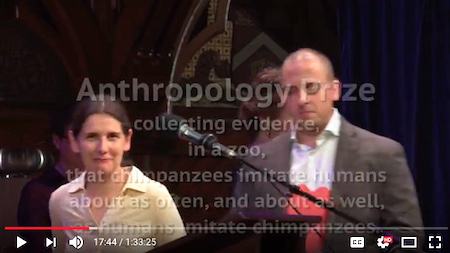

News roundup (except in Boston): Ig Nobel Prizes Tonight!
It’s news everywhere—except in Massachusetts, where it happens.
The 28th First annual Ig Nobel Prize ceremony happens tonight, at Harvard University in Cambridge, Massachusetts (near Boston), USA. News organizations — everything from the New York Times to the Daily Mail, are alerting their readers to the coming news. TV network news crews are coming from Japan, Russia, and elsewhere, as are the major news wire services, to cover the ceremony.
It’s news everywhere—except locally. No major Boston area newspaper, TV, or radio news organization is going to cover or (probably) even mention the Ig Nobel Prizes. This continues a tradition from most of the 28 years the ceremony has been in existence.
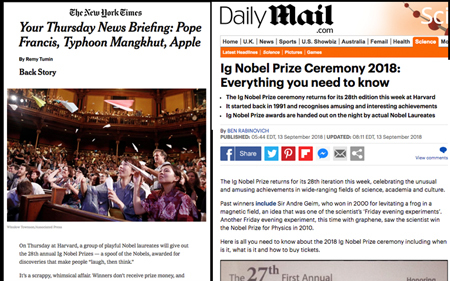
If you have friends in the Boston area, likely they are not aware that the Ig Nobel Prizes exist, or that the event happens locally. If you love your Boston area friends, perhaps you will do them the kindness of alerting them.

September 12, 2018
Watch The 28th First Annual Ig Nobel Prize Ceremony live!
Below, please find and enjoy the live stream of this year’s Ig Nobel Prize Ceremony, held as usual at Harvard’s historic Sanders Theatre. If you begin playing the video before 5:30 PM Eastern, you will see a helpful countdown to the beginning of the ceremony.
For further information about this year’s ceremony, visit the ceremony’s dedicated page.

September 11, 2018
FIRST EVER VIOLIN-TESLA COIL DUET!
Announcement by the Harvard Physics Department:
FIRST EVER VIOLIN-TESLA COIL DUET!
Instrumentalist, singers, scientists, techies, and at least one Nobel Laureate gathered yesterday in the physics department’s SciBox to rehearse before the 28th First Annual Ig Nobel Prize Ceremony, which will be held in Sanders Theatre on Thursday, September 13….

September 10, 2018
Smiling intensity among scientists is related to greater scientific achievements (new study)
“
Using a sample of 440 scientists from a social networking site for researchers, multiple raters coded smile intensity (full smile, partial smile, or no smile) in publicly available photographs. We found that scientists who presented a full smile had the same quantity of publications yet of higher quality”
See: Lukasz D. Kaczmarek, Maciej Behnke, Todd B. Kashdan, Aleksandra Kusiak, Katarzyna Marzec, Martyna Mistrzak & Magdalena Włodarczyk (2017): Smile intensity in social networking profile photographs is related to greater scientific achievements, The Journal of Positive Psychology.
A full copy of which may be found here.
Note: The image is from lead author Dr Kaczmarek’s website
[ Research research by Martin Gardiner ]

September 7, 2018
“The Duck Guy” in German—A Book for All Ages
Today is publication day for the German edition of Kees Moeliker’s Tell-All-About-The-Duck book. As you probably know, Kees was awarded the 2003 Ig Nobel Prize for biology, for his research study “The first case of homosexual necrophilia in the mallard Anas platyrhynchos.” This nifty video shows Kees gamely talking about it in German, rather than his native Dutch.
The Original Dutch title is De Eendenman. The German edition, is called Der Entenmann: Von Spatzenklöten, aussterbenden Filzläusen und nekrophilen Enten. Mysteriöse Todesfälle aus dem Tierreich. If you prefer numbers, you’ll note that the ISBN is 978-3841906106.
The book’s name translates, into English, as “The Duck Guy.” If you prefer English, you will have to wait until some sensible, greedy book publisher wises up and asks Kees to do an English language edition. In the meantime, you can see and hear Kees telling the basic story of the duck, in this TED Talk (which you can also find by Googling the four words “TED Talk dead duck”):
Kees Moeliker, an ornithologist, is director of the natural history museum in Rotterdam. You are always welcome to visit him and the preserved remains of one of the ducks, at the museum. The most fun time to visit, of course, in any year on June 5, when the museum and the city of Rotterdam celebrate Dead Duck Day, on the anniversary of the incident, involving two ducks and a glass wall, that led to all this.
UPDATE: Kees interviewed on the DAS! TV program, September 7, 2018
UPDATE: “Die tote Ente ist immer dabei“, Spiegel, September 7, 2018

September 6, 2018
One week from today: The 2018 Ig Nobel Prize Ceremony
The 28th First Annual Ig Nobel Prize ceremony will happen on Thursday evening, September 13, at Harvard’s Sanders Theatre. A few TICKETS are still available. The ceremony will be webcast live. Please join us, one way or another!
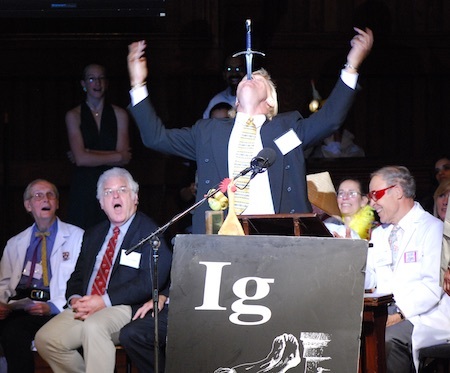
(This photo shows the acceptance speech for the medicine prize at the 2007 Ig Nobel Prize ceremony.)

“Cat Typing” – towards a possible remedy
Opportunities for Animal Computer Interactions (ACI) are, it seems, in ascendance :
“Take, for instance, the phenomenon where a cat walks on a keyboard when its owner is trying to work. This is called “cat typing”, and it results when the cat wants to be near the owner, and is attracted to the typing motions and sounds. Unfortunately, the owner is often forced to keep the cat at a distance to comfortably use the computer for work. By this fashion, people give priority to their own comforts. We believe that it is important for both people and pets to reinforce their symbiotic needs and comfortably live with one another.”
A new research project from Rina Sasaki and Yu Suzuki at Miyagi University, Japan, have, between them, developed CATouch! – an ACI system which aims to distract errant cats sufficiently that they don’t engage in typing.
“
A cat toy system that consists of an owner’s PC and an accompanying tablet for a cat. The CG animations, based on the owner’s PC operations, are displayed on the tablet. When the cat touches in the CG animations displayed on the LCD screen, the animations are generatively changed and a sounds are produced.”
They conducted a suite of experiments with 5 cats, the results of which indicated, at least to some degree, “a positive correlation between cat entertainment and having access to their own equipment” – to put that in context :
“Only Cat5, a 2-year-old female, was interested in CATouch! and played with the tablet. Other cats (i.e., mature/kitten, male/female) never played, regardless of age and sex.”
“As a result, the three phenomena clarified in this experiment are not facts but were identified as hypotheses.”
See: Sasaki R., Suzuki Y. (2018) An Interactive Cat Toy Interfacing Owner PC Operations. In: Kurosu M. (eds) Human-Computer Interaction. Interaction Technologies. HCI 2018. Lecture Notes in Computer Science, vol 10903. Springer, Cham.
A previous (full) version of the paper is available here in Japanese.
BONUS : Chris Niswander of Tucson, Arizona, who won the year 2000 Ig Nobel prize for Computer Science, is author and provider of the PawSense software suite, which not only detects when a cat is walking across your keyboard, but also makes a sound that annoys them: “This teaches your cat that getting on the keyboard is bad even if humans aren’t watching.”
software suite, which not only detects when a cat is walking across your keyboard, but also makes a sound that annoys them: “This teaches your cat that getting on the keyboard is bad even if humans aren’t watching.”
[ Research research by Martin Gardiner ]

September 5, 2018
Official Delegations at the Ig Nobel Prize ceremony
If your group of five or more people has tickets to the Ig Nobel Prize Ceremony, you can be—together as one!—an Official Delegation. We will Officiously announce your Official Delegation during the ceremony, showering you, if ever so briefly, with glory.
Just register as an Official Delegation. But… please do it soon! The deadline to register a delegation is almost here!

Marc Abrahams's Blog
- Marc Abrahams's profile
- 14 followers


